Abnormal Posture: Physiotherapy Exercises
Defination of Abnormal Posture: (Bad Posture)
Abnormal Postural dysfunction or “Poor” posture is defined as when our spine is positioned in unnatural positions, in which the curves are emphasized and this results in the joints, muscles, and vertebrae being in stressful positions. This prolonged poor positioning results in a build-up of pressure on these tissues.
Introduction: Abnormal Posture
- Abnormal posturing refers to rigid body movements and chronic abnormal positions of the body.
- When a muscle contracts, the muscles on the other side of the joint normally offer some resistance to the contraction.
- In abnormal posturing, however, the muscle groups fail to offer resistance when a muscle contracts.
- This results in atypical movement of the head or back, or stiff or arched feet. This symptom is not the same as showing poor posture or slumping over. Rather, it’s a tendency to hold a particular body position or to move one or more parts of the body in an abnormal way.
- Many abnormal posturing behaviors are the result of a serious spinal cord or brain injury.
Normal Posture:
If you want to know about abnormal posture, you need to have some idea of normal posture.

Posture is the attitude assumed by the body either when the body is stationary or when it is moving. Posture is attained as a result of the coordinated action of various muscles working to maintain stability. Posture in easy terms can be understood as the position in which you hold your body when standing or sitting.
Types of Postures:
The postures are basically divided into two types:
- Inactive
- Active
- Inactive postures- These are postures or attitudes adopted for resting or sleeping. They require theoretically minimal muscle activity and are usually assumed in need of relaxation.
- Active posture – The integrated action of many muscles is required to maintain active postures, they are basically divided into two types:
- Static postures- Body segments are aligned and maintained in a fixed position. This is usually achieved by coordination and interaction of various muscle groups that are working statically to counteract gravity and other forces. Examples of static postures are standing, sitting, lying, and kneeling.
- Dynamic postures- In this type of posture body segments are moving. it is usually required to form an efficient basis for movement. Muscles and non-contractile structures have to work to adapt to changing circumstances. Examples are walking, running, jumping, throwing, and lifting.
Ideal posture:
- As is true for any testing, there must be a standard, the same holds true for assessing postural alignment.
- The ideal skeletal alignment is known as Ideal posture or Standard posture. To get an understanding of ideal posture, we need to know the ideal alignment of the spine and other joints at rest.
- This is usually done by observation or using a plumb line, the line of gravity should pass through specific points of the body if it is to be called ideal posture. On examination the body should be viewed from four aspects; anteriorly, posteriorly, and sides(left and right).
- The ideal “normal” erect posture is one in which the line of gravity (the vertical line drawn through the body’s Centre of gravity) when viewed from each side runs.
HOW TO MEASURE POSTURE?
- The line of gravity passes through the external auditory meatus
- Then through the shoulder joint
- Approximately midway from the trunk, going through the bodies of the cervical and lumbar vertebra
- At hip joint joint it passes through the hip joint, approximately through the greater trochanter of the femur
- Anterior to the knee joint
- Anterior to lateral malleolus
- When viewed from either the front or the back, the vertical line passing through the body’s center of gravity should theoretically bisect the body into two equal halves, with the body weight distributed evenly between the two feet.
Posture Assessment
In assessing posture, symmetry and rotations/tilts should be looked out for in the anterior, lateral, and posterior views. Assess:
- Head alignment
- Cervical, thoracic, and lumbar curvature
- Shoulder level symmetry
- Pelvic symmetry
- Hip, knee, and ankle joints
Muscle action in posture:
The balanced posture of the body reduces the work done by the muscles in maintaining it in an erect posture. It has been determined (using electromyography) that, in general:
- The intrinsic muscles of the feet are quiescent, because of the support provided by the ligaments.
- Soleus is constantly active because gravity tends to pull the body forward over the feet. Gastrocnemius and the deep posterior tibial muscles are less frequently active.
- Tibialis anterior is quiescent (unless high heels are being worn).
- Quadriceps and the Hamstrings are generally quiescent.
- Iliopsoas is constantly active.
- Gluteus maximus is quiescent.
- Gluteus medius and tensor fascia latae are active to counteract lateral postural sway.
- Erector spinae is active, counteracting gravity’s pull forwards.
- The abdominal muscles remain quiescent, although the lower fibres of the Internal obliques are active in order to protect the inguinal canal.
ABNORMAL POSTURE TYPES
Types of spine curvature disorders:

There are three main types of spine curvature disorders, including:
- Sway Back: Abnormally exaggerated forward curvature of the lumbar and cervical regions of the spine.
- Lordosis. Also called swayback, the spine of a person with lordosis curves significantly inward at the lower back.
- Kyphosis. Kyphosis is characterized by an abnormally rounded upper back (more than 50 degrees of curvature).
- Scoliosis. A person with scoliosis has a sideways curve to their spine. The curve is often S-shaped or C-shaped.
- Forward Head Posture: A forward head posture (FHP) or poking chin involves increased flexion of the lower cervical vertebrae and the upper thoracic regions, increased extensions of upper cervical vertebrae, and extension of the occiput on C1.
Other Types of Abnormal Posture:
There are other three types of postures that may be seen among individuals with abnormal posturing:
- Opisthotonos is a posture in which the neck is tilted back and the back is stiff and arched.
- Decorticate posture is characterized by a stiff body, straight legs, and clenched fists.
- Decerebrate posture is characterized by rigid limbs, pointed toes, and a backward tilt to the head and neck.
Causes of Abnormal Posture:
- Contributing Factors To Postural Dysfunction
- Lack of education or awareness of correct posture
- Sedentary lifestyle
- Occupational demands
- Joint stiffness
- Decreased fitness
- Muscle tightness
- Poor core stability
- Poor ergonomic work-stations
- Abnormal posturing most often results from damage to the brain or spinal cord. The type of posturing you experience will
- depend on the specific area of the brain or spinal cord that was affected.
AREA OF PAIN in Abnormal Posture:
- Low back pain is the most frequent complaint but research shows neck, shoulder, and arm pain has become increasingly widespread as a result of postural dysfunction. Foot and knee problems are also becoming more common due to the emphasis on running and fitness.
- Body aches and pains including upper or lower back pain, neck, shoulder and arm pain.Lower limb pain including leg and hip, knee, or ankle pain
- Muscle fatigue
- Headaches due to a build-up of tension in the upper back, neck, and shoulders
ERGONOMICS ( Spine of Care ): Preventing Abnormal Posture
- controlling blood pressure
- controlling blood sugar levels
- controlling cholesterol levels
- quitting smoking if you smoke
- exercising at least three times per week
Physiotherapy Treatment of Abnormal Posture:
Physiotherapy treatment may significantly help to minimize, if not eliminate, postural dysfunction. Most patients will experience decreased pain once their posture is corrected. Physiotherapy Treatment may Include:
- Assessment and diagnosis of postural habits
- Postural education and training
- Manual therapy and soft tissue massage
- Dry needling
- Postural taping
- Electrotherapy
- Joint mobilization
- Corrective exercises and movements to improve flexibility, strength, and posture
- Activity modification advice
- Advice regarding ergonomic workstations
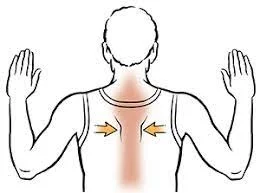
EXERCISE
- Shoulder Blade Squeeze
Begin sitting or standing tall with your back and neck straight. Squeeze your shoulder blades together as far as you can go - without pain provided you feel no more than a mild to moderate stretch. Hold for 5 seconds and repeat 10 times provided
- the exercise is pain-free. Repeat 3 – 5 times daily.

- Chin Tucks
- Begin sitting or standing tall with your back and neck straight, shoulders should be back slightly. Tuck your chin in as far as you can go without pain provided you feel no more than a mild to moderate stretch. Keep your eyes and nose facing forward.
- Hold for 2 seconds and repeat 10 times provided the exercise is pain-free. Repeat 3 – 5 times daily.

- Wall Angle
- Standing upright against a wall, move your feet slightly out, tuck your chin in, and ensure your tailbone upper back, and head remain against the wall. Breathe in and raise your arms up the wall, maintaining a 90-degree angle and keeping your elbows and hands on the wall. Repeat five times. Take it one step further by rotating down the wall to each side. Repeat five times. Repeat both exercises 2 times daily.
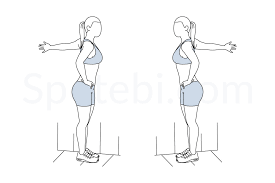
- Chest Stretch
- To start, place your forearm on a device such as a pole or a wall. Keeping your arm at 90 degrees, lean outwards, feel the stretch in your chest, and hold for 15 – 20 seconds.
- Then put your hand on the device lengthen your arm slightly turn your body outwards and hold for 15 to 30 seconds.
- Finally, leaving just your fingertips on the device, extend your arm and turn even further, holding again for 15 – 30 seconds.
- Swap sides and repeat with the other arm.
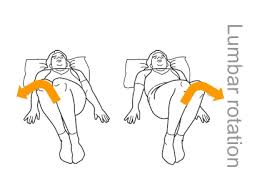
- Lumbar Rotation
- Start by lying on your back with your knees bent and your arms out to the side in a ‘T’ position.
- Rotate your knees to one side, attempting to touch the floor, whilst looking over the opposite shoulder.
- Hold for 10 seconds before raising your top leg back to the center first, followed by the bottom leg, and then repeat on the opposite side.
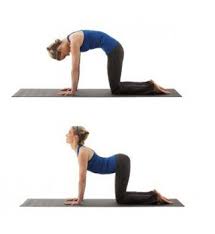
- Cat and Camel Poses
- Start on your hands and knees with your hands directly below your shoulders and your knees directly below your hips.
- Gently tuck your chin in towards your chest and round up your middle back, drawing in your abdominals and tucking your tailbone under.
- Then stick out your buttocks and let your chest and stomach sag whilst looking forward.
- Repeat four times.

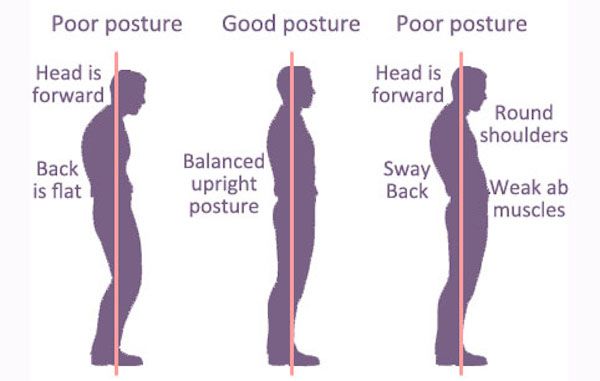
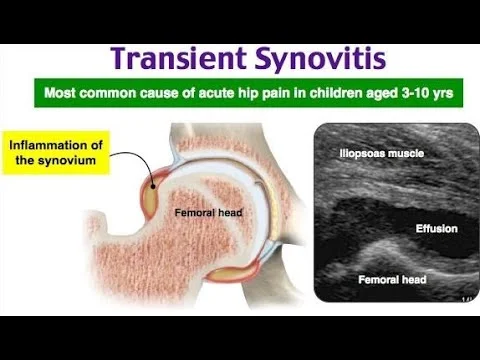

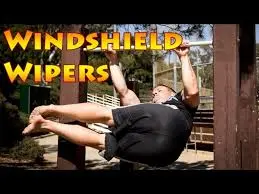

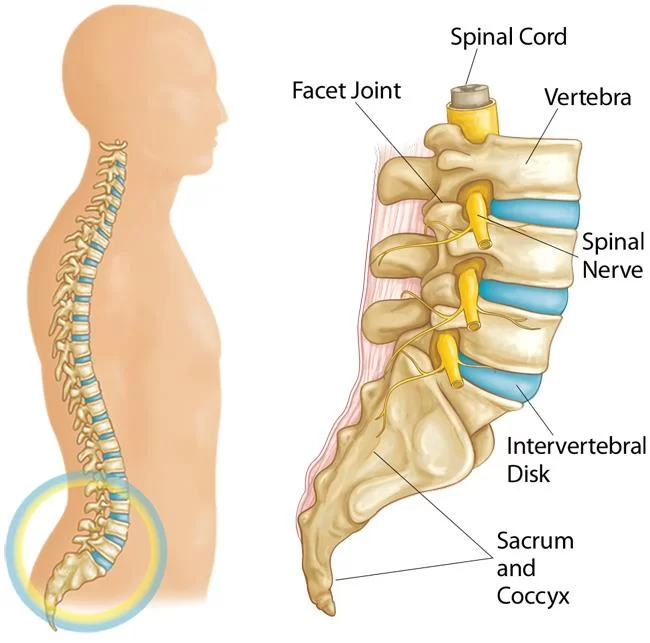
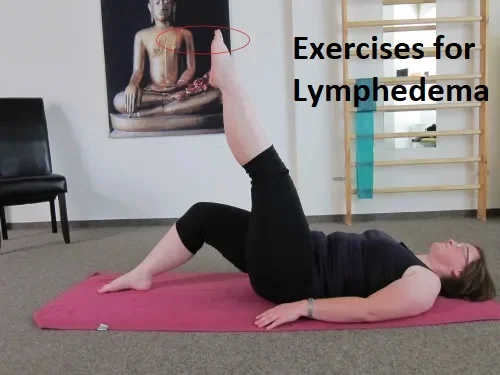
3 Comments